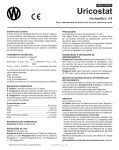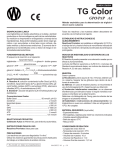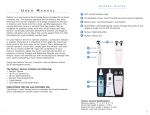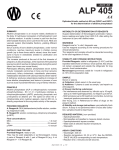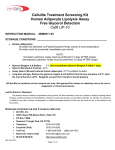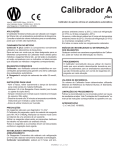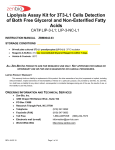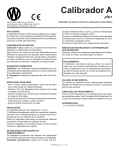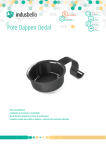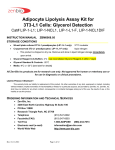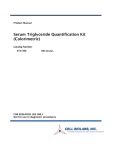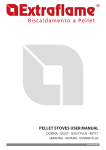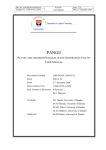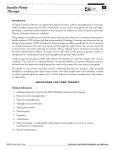Download Uricostat enzimático AA
Transcript
LIQUID LINE Uricostat C enzimático AA For acid uric determination in serum, plasma or urine SUMMARY Uric acid is a metabolite found in purines, nucleic acids and nucleoproteins Serum uric acid concentration usually varies from one individual to another depending on several factors such as: sex, diet pattern, ethnic origin, genetic constitution, pregnancy. Abnormal levels of serum uric acid indicate metabolic disorders of its precursors or inadequate excretion. PRINCIPLE The analytical system is based on the following reaction: UOD uric acid + 2 H2O + O2 allantoin + H2O2 + CO2 POD 2 H2O2 + 4-AP + 3,5-DHS quinoneimine The amount of uric acid is determined by measuring the absorbance of this pigment. UOD: uricase POD: peroxidase 4-AP: 4-aminophenazone 3,5-DHS: 3,5-dichlorohydroxybenzene sulfonic acid, sodium salt. PROVIDED REAGENTS S. Standard*: 10 mg/dl uric acid solution. A. Reagent A: solution containing Good buffer pH 7.8 and 3,5-dichlorohydroxybenzene sulfonic acid, sodium salt (DHS). B. Reagent B: solution containing Good buffer pH 7.8, 4-aminophenazone (4-AP), uricase (UOD), peroxidase (POD), and potassium ferrocyanide. Final concentrations Good Buffer.......................................................... 50 mmol/l UOD....................................................................... > 200 U/l POD..................................................................... > 1000 U/l 4-AP................................................................... 0.10 mmol/l Potassium ferrocyanide........................................... 6 umol/l DHS..................................................................... 2.0 mmol/l NON-PROVIDED REAGENTS Wiener lab's Calibrador A plus. INSTRUCTIONS FOR USE Standard: ready to use. Reagents A and B: ready to use. They can be used separately or as a Monoreagent mixing 4 parts of Reagent A + 1 part of Reagent B (e.g. 4 ml Reagent A + 1 ml Reagent B). WARNINGS Reagents are for “in vitro” diagnostic use. Do not ingest. * Non-provided with all kit sizes Avoid the contact with skin and eyes. If spilt, thoroughly wash affected area with water. Use the reagents according to the working procedures for clinical laboratories. The reagents and samples should be discarded according to the local regulations in force. STABILITY AND STORAGE INSTRUCTIONS Provided Reagents: stable in refrigerator (2-10oC) until the expiration date printed of label. While in use, do not keep without refrigeration for extended periods of time. Avoid contamination. Monoreagent (pre-mixed): in refrigerator (2-10oC) is stable for 1 month since preparation date. INSTABILITY OR DETERIORATION OF REAGENTS - Failure to recover control values within the assigned range (Standatrol S-E 2 niveles) could indicate deterioration and the Reagents should not be used. - Turbidity indicates Reagents deterioration. Do not use. - Blank absorbance reading exceeding 0.200 O.D. or Standard readings abnormally low, may indicate deterioration and the Reagents should not be used. SAMPLE Serum, plasma or urine a) Collection: obtain serum or plasma as usual. Remove serum from clot as soon as possible within two hours from collection. If urine is used, it should be preferably fresh. b) Additives: when using plasma, use only heparin-based anticoagulants. c) Known interfering substances: - Strongly reducing substances, such as ascorbic acid (vitamin C), Buscapina (butyl-hyoscine bromide), interfere with the test. Therefore, therapy with ascorbic acid should be discontinued 24 hours before sample collection whenever possible. - No interference was observed from: bilirubin up to 10 mg/dl (100 mg/l), triglycerides up to 490 mg/dl (4.9 g/l), hemoglobin up to 180 mg/dl and heparin up to 100 U/ml. See Young, D.S. in References for effect of drugs on the present method. d) Stability and storage instructions: samples should be preferably fresh. If assay cannot be immediately performed, serum or plasma samples may be stored for up to 3 days at 20-25oC, 7 days at 2-10oC or 6 months at -20oC without preservatives. Urine samples may be stored at pH > 8 for up to 4 days at 20-25oC. Do not refrigerate or freeze. 864127522 / 01 p. 7/9 REQUIRED MATERIAL (non-provided) - Spectrophotometer or photocolorimeter. - Adequate volumetric material. - Tubes or spectrophotometric square cuvettes. - Water bath at 37oC. - Watch or timer. ASSAY CONDITIONS - Wavelength: 505 nm in spectrophotometer or in photocolorimeter with green filter (490-530 nm). - Reaction temperature: 37oC or 18-25oC - Reaction time: 5 minutes at 37oC or 20 minutes at 18-25oC - Sample volume: 20 ul - Final reaction volume: 1.02 ml Sample and Reagent volumes may be proportionally decreased or increased (e.g. 50 ul Sample + 2.5 ml monoreagent or 10 ul Sample + 500 ul monoreagent). MANUAL PROCEDURE I- TWO REAGENTS TECHNIQUE In three tubes or spectrophotometric cuvettes labeled B (Blank), S (Reagent S or Calibrator) and U (Unknown), add: B S U Standard - 20 ul - Sample - - Reagent A 800 ul 800 ul 800 ul 20 ul Reagent B 200 ul 200 ul 200 ul Mix gently and incubate for 5 minutes in water bath at 37oC or for 20 minutes at room temperature (18-25oC). Remove from bath. Read in spectrophotometer at 505 nm or in photocolorimeter with green filter (490-530 nm), setting the instrument to zero O.D. with the Blank. II- MONOREAGENT TECHNIQUE Follow steps as described in Technique I, using 1 ml of Monoreagent prepared following the Instructions for use. III- URINE TECHNIQUE Follow the above technique (I or II) diluting the sample 1/10 with water or saline. Calculate the results, multiplying by the dilution factor used. STABILITY OF FINAL REACTION Final reaction color is stable for 30 minutes, thus, absorbance should be read within that period. CALCULATIONS 10 mg/dl(1) uric acid (mg/l) = U x f where f = S (1) When Calibrador A plus is used, see the uric acid concentration in its package insert. U: absorbance reading of the unknown. S: absorbance reading of the Standard or Calibrator. Example: U = 0.134 S = 0.284 Uric acid in the Standard = 10 mg/dl f = 10 mg/dl / 0.284 = 35.21 mg/dl Uric acid in the sample = 0.134 x 35.21 mg/dl = 4.72 mg/dl QUALITY CONTROL METHOD Each time the test is performed, analyze two levels of a quality control material (Standatrol S-E 2 niveles) with known uric acid concentration. REFERENCE VALUES Sera from 120 fasting individuals from both sexes, with ages ranging from 20 to 45 years, living in or near Rosario (Argentina), with no symptoms of gout, gouty nephropathy, urate nephrolithiasis or other apparent disease, were analyzed with Uricostat enzimático AA líquida. The central 95% of the results covers the following range: Men: 2.5-6.0 mg/dl Women: 2.0 -5.0 mg/dl In the literature (Tietz, N.W.) the following reference value range is mentioned: Serum or plasma Men: 3.5-7.2 mg/dl Women: 2.6-6.0 mg/dl Urine 250 a 750 mg/24 hours It is recommended that each laboratory establishes its own intervals and reference values, taking into consideration age, sex, dietary habits and other factors. SI SYSTEM UNITS CONVERSION Uric acid (mg/dl) x 0,059 = Uric acid (mmol/l) Uric acid (mg/24 hs) x 0.0059 = Uric acid (mmol/24 hs) PROCEDURE LIMITATIONS See Known interfering substances under SAMPLE. PERFORMANCE The assays were performed in a Express plus(*) analyzer. If using the kit with manual procedure, user must validate that similar performance to that stated below is obtained. a) Reproducibility: precision studies were performed according to the guidelines contained in CLSI (ex NCCLS) document EP5-A and the following values were obtained: Intra-assay Level 3.39 mg/dl 5.36 mg/dl S.D. ± 0.075 mg/dl ± 0.071 mg/dl C.V. 2.21 % 1.32 % S.D. ± 0.097 mg/dl ± 0.102 mg/dl C.V. 2.86 % 1.90 % Inter-assay 864127522 / 01 p. 8/9 Level 3.39 mg/dl 5.36 mg/dl (*) TM Ciba Corning Diagnostics b) Sensitivity: based on an instrument minimal reading of 0.001 O.D. minimum detectable change in concentration under those conditions will be of approximately 0.03 mg/dl. c) Linearity: linearity studies were performed following the guidelines contained in CLSI (ex NCCLS) document EP6P. The reaction is linear up to 20 mg/dl. For higher values, repeat the determination using half sample volume and multiply final result by 2. d) Correlation: - Serum and plasma: uric acid values of 100 specimens were determined using Uricostat enzimático AA líquida and Uricostat enzimático AA. The correlation coefficient was: r = 0.9971, slope b = 1.0167 and intercept a = - 0.2225. - Manual vs. automated procedures: uric acid values of 30 samples were determined using the Uricostat enzimático AA líquida kit with both manual and automated methods. Sample uric acid concentrations covered a range from 1.7 to 18.2 mg/dl. Correlation coefficient between manual and automated methods was: r = 0.9971; slope b = 0.9893; intercept a = 0.2792. PARAMETERS FOR AUTOANALYZER For programming instructions check the user’s manual of the autoanalyzer in use. For calibration, it must be used a serum based calibrator (Wiener lab.'s Calibrador A plus). WIENER LAB. PROVIDES - 225 ml (3 x 60 ml Reagent A + 3 x 15 ml Reagent B), Standard not included (Cód. 1009320) - 225 ml (3 x 60 ml Reagent A + 3 x 15 ml Reagent B), Standard not included (Cód. 1009635) - 250 ml (2 x 100 ml Reagent A + 1 x 50 ml Reagent B), Standard included (Cód. 1840107) - 400 ml (8 x 40 ml Reagent A + 4 x 20 ml Reagent B), Standard not included (Cód. 1009277) - 500 ml ((4 x 100 ml Reagent A + 1 x 100 ml Reagent B), Standard included (Cód. 1840110) REFERENCES - International Federation of Clinical Chemistry - Clin. Chim. Acta 87/3:459 F (1978). - Trinder, P. - Ann. Clin. Biochem. 6/24 (1969). - Young, D.S. - Effects of Drugs in Clinical Laboratory Tests, 3rd Ed., AACC Press, Washington DC, (1990). - NCCLS document "Evaluation of the Linearity of Quantitative Analytical Methods", EP6-P (1986). - NCCLS document "Evaluation of Precision Performance", EP5-A (1999). - Tietz Fundamentals of clinical chemistry - Burtis, C., Ashwood, E. (5th Edition) WB Saunders, 2001. SYMBOLS The following symbols are used in packaging for Wiener lab. diagnostic reagents kits. C This product fulfills the requirements of the European Directive 98/79 EC for "in vitro" diagnostic medical devices P Authorized representative in the European Community V "In vitro" diagnostic medical device X Contains sufficient for <n> tests H Use by l Temperature limitation (store at) Do not freeze F Biological risks Volume after reconstitution Cont. Contents g Batch code M Manufactured by: Xn Harmful Corrosive / Caustic Xi i Calibr. b b c h Irritant Consult instructions for use Calibrator Control Positive Control Negative Control Catalog number M Wiener Laboratorios S.A.I.C. Riobamba 2944 2000 - Rosario - Argentina http://www.wiener-lab.com.ar Dir. Téc.: Viviana E. Cétola Bioquímica A.N.M.A.T. Registered product Cert. Nº: 3464/99 864127522 / 01 p. 9/9 Wiener lab. 2000 Rosario - Argentina UR120903



